Hokepoints Goes Over: Level II

Read Level I: The Defensive Line
Click to big. Right-click to open in a separate window so you can reference it as you go.
A few weeks ago I promised to finish this piece on the differences for Michigan's personnel in the 4-3 over. Sorry.
Refresher: What's a 4-3 Over? What you're looking at are alignments of the front seven. The "under" shifts the defensive line away from the strength of the defense and the linebackers swing the opposite way to compensate. Michigan would often align this to the hash rather than the offense, shifting the DL toward the sideline.
The "over" shifts the line the opposite way, but not to such an extreme. The linebackers wind up centered over the ball, and the DL spread across the formation. There is nothing 3-4 about it except the nose tackle.
Last time I talked about how going from a base under to a base over will demand the WDE and 3-tech play a little bigger, the SDE can play more like a rush end, and the nose's job stays pretty much the same except he's now the backside DT. Now on to the second level.
Strongside Linebacker (SAM): James Ross/Royce Jenkins-Stone
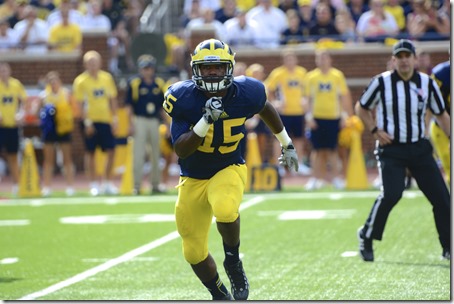
[Upchurch]
The 4-3 under is tough to run against—often they wind up blocking the backside DE in hopes of getting something from a cutback, since it's hard for the LT to get to anybody else. That meant the WLB could be a free hitter
On inside zone that strongside (right) tackle is trying to get a free release. The 3-tech could get aggressive and slow him up but the danger of playing aggressively on the DL against a zone running team is you open up the backside. The faster the OT gets out to the second level the more room there's going to be for the running back to dodge around the DT. A SAM who can read IZ quickly will be all up in that OT's face, able to affect both frontside gaps without opening up the backside cut. Every half-second of delay on the SAM's part is another yard for the offense.
But the SAM can't get crazy-aggressive attacking the OT or the C gap because that tight end is an eligible receiver, and there's another receiver on that side of the formation who could be slanting or dragging. Since the guess is Michigan wants Jake Ryan to be aggressive in the middle, Ross will end up in a lot of zone drops or in man-to-man on the tight end.
The fit: The WLB in the 4-3 under that James Ross played last year isn't hugely different, but it wound up playing differently because Ross was constantly having to take on blockers thanks to Michigan's Jibreel-Black-is-a-NT stunt-a-thon. His quick-twitch reads will be an asset, and his speed and coverage ability will be also. Michigan State's defense had Denicos Allen blitz a ton from this position, and got away with it because the handsy press coverage took care of the slant/drag passes that punish it, and because they had Max Bullough to read and react at MLB. Ross will get to blitz more than he did as the backside linebacker, but I'm guessing Michigan would rather he be the read-react-hit-spill dude so Jake Ryan can go viking.
[jump for the other two spots]
Middle Linebacker (MIKE): Jake Ryan/Joe Bolden
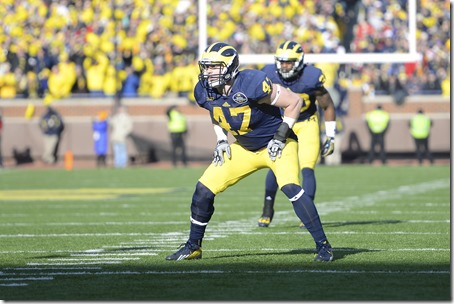
In the Under: The MLB lined up over the strongside guard. This again is where it's helpful to think of the 4-3 under as a 3-4, where the MLB is the strongside guy of the two middle linebackers. He split coverage duties with the WLB and really the only difference is he's a little bit more likely to take on a blocker in the run game due to the extra blocker over there. The MLB's job is to get off those blocks and plug up the run game. He also winds up having a lot of coverage duties, so he's got to read and react to the play. He's a guard-reader, since a pull by the backside guard means the MLB is going to have to get playside of that puller, while also making sure they're not going to whoop a pass behind him as he does so.
Michigan's didn't so much, but many 4-3 under and 3-4 defenses like to use a coverage middle linebacker to cover a "Tampa 2" zone, meaning the MLB will cover some of the deep centerfield so the safeties can be more aggressive on the outside or against the run. That staple play of a 4-3 even worked well in practice because the vertical seam threat it guards against usually comes from a strongside receiver. Notre Dame with Te'o is a case example of this. Penn State does it with Hull. Michigan used to do it with Demens. It's a good way to compensate for weakness at safety.
In the Over: The MLB is often the best defender in an Over defense. He lines up over the center, and goes wherever the ball does. Often he wracks up huge tackle totals. One defensive coach I talk to always speaks in terms of "spill" players versus "box" players. The 4-3 under SAM is a good example of a "spill" guy—his job is to control the direction of the play. The MLB in a 4-3 over is the consummate "box" guy—his job is to be there when the play comes his way.
On stretch plays he needs to go sideline to sideline, on power plays he needs to blow up the lead blocker—preferably where the blast radius takes out several other offensive players—and on zone runs he's got to sift through the madness and get to the ball. He's a bit more protected from blockers because he's got the nose tackle in front of him. He's in an excellent position to blitz the middle, but also can end up taking deep coverages.
The differences in the over versus under are not so major. Because he's literally the middle defender, I guess the defense can play to the MLB's strengths. If he's great in coverage you can play a lot of quarters defense and blitz the safeties, trusting your MIKE can still make the play. If he's a fantastic blitzer you can run a lot of frontside A-gap blitzes, which are particularly helpful to the DTs against zone running offenses since the guard and center have to start worrying about some knife coming through instead of concentrating on what the guy in front of him is doing.
The Fit: Well that's the big question isn't it? Jake Ryan was the perfect SAM for a 4-3 under, but now his DE-ness doesn't help him except in getting off of blocks, and he has to temper the aggression that made him such an effective player so that he isn't run out of the play. Let's take a look at a popular 4-3 over nemesis, the backside ISO:
Young RBs screw this up all the time because they'll see that WLB charging into their hole and try to bounce it outside. Outside is where the OT just put the WDE, and the MLB should be free and flowing. Follow your blockers, kids.
This is a quick-hitting play you can run out of all sorts of formations: single-back teams will use an H-back or U-tight end as the lead blocker, while dual-threat QB offenses can send a running back as lead blocker. "ISO" is short for "Isolation." It was the base play of everybody when I was in high school in the mid-'90s. It's got very manly things going for it: the nose guard is double-teamed at the point of attack, the DE can get kicked, and there's no pulling to give away your play—just a lead blocker screaming into the hole in front of the ballcarrier (everybody wanted to play fullback for this reason). Then there's one defender who can stop it, and he is isolated against the running back. If your running back is a huge dude versus a small MLB, that collision is going to get three more yards after it occurs. If the MLB is a manbeast who rages into the gap, the play goes for zilch, impressively.
It's a great play to run against 4-3 over defenses because it checks the defense against getting too aggressive in attacking the frontside, and also attacks the rather wide gap between the nose tackle and the WDE. Space Coyote mentioned in the comments of Part I that teams will often move that WDE out further so he's not always in a 5-tech (over the OT's shoulder). That's true, and that you can do if you're not expecting a backside ISO. Widen that gap further though and it's an instant 5 yards for the offense.
Even with the WDE staying tight, MIKE linebackers have to react really quickly to stop this, and coming in the backside gap screws with them because they're always expecting the frontside first. Catch him waiting and it's the same result as a hesitant SAM. Catch him blitzing the frontside and it's the WLB versus two guys coming right at him.
So soundness in this defense is going to rely on Jake Ryan knowing where the play's going before he reacts, which is new to him. He's been fine against blockers in the past, but as a spiller, not a box. It's a rocky fit. If the defense is indeed aggressive though it can work, since it does put your best defensive player in the middle of every play.
As for Bolden, his job doesn't change much. He's a talker I believe, which is good for a position that's kind of the defense's quarterback. He wasn't good at taking on blocks last year or at coverage, so his weaknesses aren't mitigated by the over.
Weakside Linebacker (WILL): Desmond Morgan/Ben Gedeon/Joe Bolden
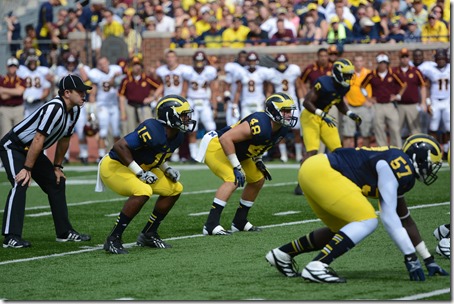
Morgan at MLB, Ross at WLB in a 4-3 under
In the Under: This is the MLB's fellow middle buddy who takes on fewer blockers because he's on the weak side. Traditionally he's been the more pass-defendy of the two because he winds up taking the zone between the hashes in a Cov 2 (the CB will have the flat next to him and the MLB takes the wide side of the field with more safety help). The WILL has to pick through the trash and make the tackle. He's usually a "box" guy except against weird formations that spread him out.
In the Over: This linebacker position changes the least. If anything he becomes a little bit more of a DE because offenses often balance their formations with a U-back to the WLB's side—he gets that guy and ends up kind of like the SAM in a 4-3 under.
In general though the WLB is a coverage linebacker. The 4-3 under will often use the WDE in short zones but the 4-3 over won't be doing that, else they give up too much running room to the backside. So the WLB's going to be in coverage a lot.
In the 4-3 under against a strongside run the MLB has to take on a blocker and the WLB is the free hitter. That will happen still but often in the 4-3 over the MLB will be a free hitter because the SAM took on a block (or the WLB did if it came backside). In the zone run I showed above, the WLB has to be there for the cutbacks. In the ISO the WLB has to defeat that lead blocker.
So the biggest difference is taking on more blockers because he isn't as protected. The WLB position in the 3-3-5 that Jonas Mouton played is probably the closest analogy. MSU's WLBs were often coverage dudes. Chris Norman was. Taiwan Jones won the position from Norman by being big enough (250 lbs) to take on blocks and getting his coverage up to adequate-plus. That should tell you what's valued here.
The Fit: Morgan is an ideal WLB in the 4-3 over, which made it weird when Bolden was starting over him in spring (spring things are meaningless tag deployed). He's historically been good in coverage—that was the first trait that appeared as a freshman starter—and a plugger, which is the difference between 3 and 5 yards on a play offenses can call all the time. He also demonstrated he's better at taking on blockers.
Gedeon looked pretty good at this stuff last year too, though I haven't seen him plug a guy yet. Bolden as starter, if that wasn't just a spring thing, could work for the same MLB-ness, especially if the coaches feel they need someone quarterbacking the defense from the LB group and the seniors aren't doing that.
This is awesome. I really enjoy these posts. Very imformative. Thanks, Seth.
Thank you for the continuing education credits. Your write-ups really bring dummies like me up to speed.
I don't know how much you're going to be able to see the Michigan defense even align this way. If they could, I don't think they would have felt the need to switch to the over front and put Ryan at MLB. The problem was that the offensive alignement was forcing the SAM out of the box and out on a slot WR. This wasn't allowing Ryan to make an impact on inside run plays. So I'd imagine they were willing to sacrifice Ross and RJS at SAM to get Ryan more involved. Then you switch the over because if you do see a pro look the SAM in the over fits Ross and RJS more than the under. If they aren't expecting this then I just don't see the need to make the switch scheme wise or personnel wise. Correct me if I'm wrong.
Maybe a part 3 of this series can look at the adjusted alignments vs a spread look.
Nice write up Seth. I said it in the other thread as well, but you want to look to the Chicago Bears to see what a 4-3 Over looks like.
This highlight video has a lot of replays/highlights, but it also shows a lot of full plays of Urlacher doing exactly what MLBs should do. There's film of him shooting the gap on run plays, playing the deep middle, etc. Linebacker play will depend a lot on the DL. If the LBs can flow freely, good things happen. If the LBs always have OLs in their face, bad news.
The Bears have run the over since Lovie arrived, but they ran it with a lot of zone behind it. When they were at their peak, it was almost exclusively zone. They were essentially Bend but Don't Break except with lots of turnovers. Blitzing was rare.
I'm assuming (with no source at all), that Michigan is planning more of an aggressive 4-3 that sees Ryan playing aggressively down hill and uses more man concepts in the back.
Do we have any idea whether that's the case?
Mattison has always been more of a single-high guy. He will likely continue to zone blitz when he can, as that's his preferred method of gaining numbers advantages, but as for a base, it looks much more likely it will be a single high coverage (likely cover 1 robber to bring the safety down into the box) with a mix of cover 3, 4, and 6 (likely in that order). Rarely does Mattison run a true cover 2 or Tampa 2 like the Bears tended to.
I also wrote up a brief summary on the transition from an under to an over front a while back, and while Seth and I mainly come to the same conclusions, it's important to note that there are several ways to run this. For instance, because the SDE forces an inside release by the TE (into the wash), the SAM generally gets a good read with his run/pass key. But if Michigan is going to play mostly cover 1 (rather than a cover 1 safety robber) they'll pick up the TE with the SS and play 3x2 with the LBs and the RBs. So coverage dictates technique and assignments as well.
There are also things you can do to change how the LBs attack the front. For instance, you can keep your SAM a bit cleaner by playing an "I" technique, which is short for "4i" or the inside shoulder of the strongside OT. This makes it more difficult for the OT to get out to the SAM, but makes it easier for the OG to get to the MIKE (the 3-tech will still try to prevent both from happening). This allows the MIKE to look to cut off the first blocker that comes up and allows the OLBs to be more slashers. MSU likes to run an "Over G", which puts the NT on the inside shoulder of the weakside OG. This makes it much more difficult for that OG to release, making the weakside Iso/inside zone to do a whole lot. Boise St, who loves weakside Iso, was snuffed out regularly with it.
So there are different ways to play the front 4 and different ways of playing LB. The MIKE can take on first blockers and the OLBs be the slashers, or the OLBs can be downhill types while the MIKE reads and reacts. My guess would be the former for Michigan.
Watch for the offense to Cage and Jam the DEs as well, flexing the OLB to the C/D gap while the DE takes the inner most gap. This makes it harder to "reach" on zone plays, while putting an bigger body that is harder to get movment closer interior, also making it harder for the OL to release. This will also be how many teams alter their defense to defend the spread. I wrote a bit about that here.
Lastly, a distinction I want to make that I talk about in my post about adjusting from Under to Over. In the Under front, Michigan played it to squeeze the ball inside. With 5 defenders on the LOS, they worked to leverage the play on the outside and constrict it between the tackles. Typically, an Over is going to do the opposite. They are going to force between the tackles, or in the "box", specifically from the MIKE and two DTs. They will try to bounce the football to the spill defenders, either the DEs, Safeties, or flowing OLBs. It's a bit of a change in philosophy, that will require a bit of change in technique (how to attack blockers, what shoulders to keep free, etc), but it is a significant difference.
Because it's easy to nitpick someone elses work (please don't do the same to mine, because I make similar mistakes all the time), you better have someone blocking the WDE on the inside zone, either by introducing another back to seal the backside, or kicking out with the weakside OT to prevent the backside end from crashing the play and preventing the cut back. Or you can have an imaginary jet fake that we just don't see because it's a diagram (fake acts as a block). But just so fans understand the new base run play on the offense, you must block or effectively block the backside end on an inside zone.
my deepest fear is that we will never be able to rush the passer again...
jdon
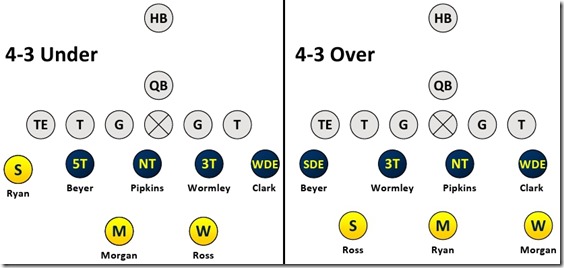
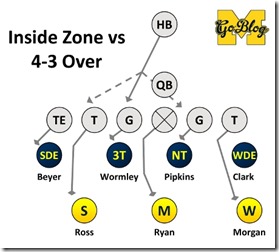

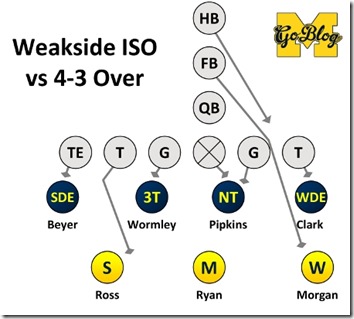
Comments